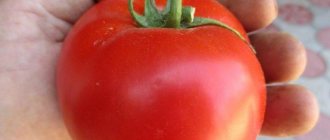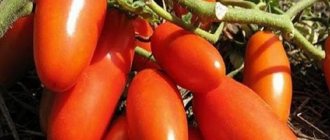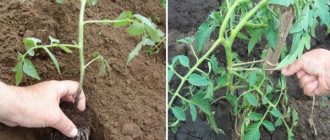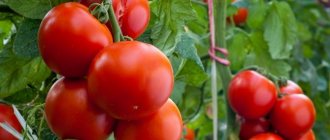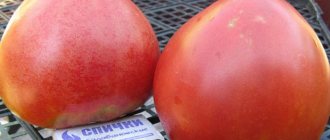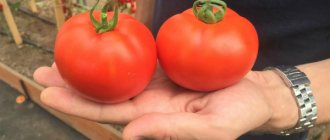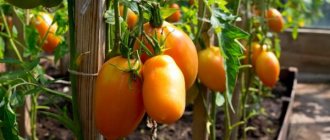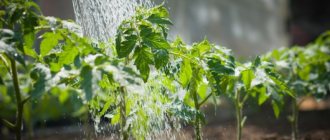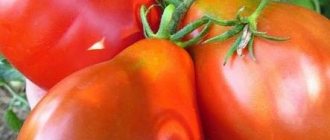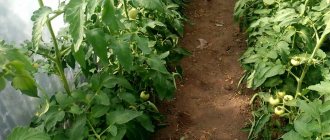Description of the Pineapple tomato variety, features of cultivation and care
Every year, new selections of garden crops appear on the horticultural market, one of which is the Pineapple tomato variety.
Experts advise lovers of unusual varieties to pay attention to the new species and appreciate the merits of yellow tomatoes. To obtain proper yield indicators, it is recommended to take into account the basic recommendations for growing the variety
Description of the variety
The Pineapple tomato is an early-ripening indeterminate species. The bushes of the plant are tall and need staking. The average height of adult shoots reaches 1.5 meters. The tomato is considered a large-fruited variety; on average, the weight of one vegetable is 250 grams. With proper care and proper removal of stepsons, it is possible to obtain giant vegetables.
The fruits are characterized by a sweetish taste, unusual for tomatoes. Reviews from gardeners note pineapple notes, which are more typical of fruit. The pulp of tomatoes is dense, but lends itself well to cutting. Due to its large size, the variety is suitable for salads and use in winter recipes.
Growing
Cultivation is carried out using seedlings. The time for planting seeds is determined depending on the desired period of harvest; on average, from the moment of germination to the harvesting of the first harvest, it takes from 110 to 115 days.
As the shoots grow, the bushes are provided with a garter and timely removal of excess greenery. Yield indicators largely depend on how well the biotechniques of cultivation are followed. On average, for every 4 clusters of plants there are 3 or 4 large tomatoes. It is recommended to form the plant into 2 or 3 stems.
Features of care
Plant care is standard. The plant needs fertile soil and several feedings throughout the growing season. The crop requires sufficient watering and does not tolerate drafts.
Pruning must be carried out in a timely manner, since excessive thickening leads to insufficient air supply and increases the risk of plant diseases.
Advantages and disadvantages
The variety got its name because of the unusual appearance of the vegetables and their specific taste. The fruits gain the greatest taste at the end of the growing season. The advantages of the type include:
- appearance and taste of pineapple and tomato;
- use of fruits fresh and in preparations;
- yield indicators;
- regulation of tomato weight.
When receiving large fruits, it is necessary to consume the fruits immediately, since the shelf life of cut tomatoes is short.
Pests and diseases
The variety has no specific characteristics and the main ones are considered to be traditional tomato pests and fungal diseases. Both a lack of watering and excessive soil moisture have a negative impact. Compliance with the rules of agricultural technology can minimize the risk of cladosporiosis and late blight.
Harvest and storage
Harvesting is carried out at the moment of full ripening of the fruits. Since the plant is an early-ripening species, in most cases the risk of obtaining unripe fruits at the end of the growing season is minimized.
When receiving such vegetables, it is recommended to place them in a cool, dark place and eat them as the vegetables ripen.
Description of the Dinar tomato and its characteristics, cultivation features
Varieties that do not require pinching include the Dinar tomato, the description of which is reflected in the characteristics of the variety. The plant belongs to the group of ultra-early ones: approximately 2.5-3 months pass from the moment the first shoots appear until harvesting.
Characteristics of the variety
Tomatoes are suitable for growing both in greenhouse conditions and in open ground. In addition to the early ripening of the variety, gardeners love the Dinar tomato for its very low plants. Basically, the height of the bushes does not exceed 50 cm, and their average height is about 40 cm. Despite such precociousness and low growth of the Dinar variety, the plants are completely covered with red, slightly elongated tomatoes, each weighing about 40-60 g. The fruits are tasty, quite sweet and juicy.
Dinar tomatoes are universal in use. Due to the small size of the fruits, they are convenient to pickle and salt. The fruits are suitable for fresh consumption and as an ingredient in salads. You should not use tomatoes for making juices and sauces, since for these purposes there are varieties whose fruits are larger in size and have more juicy pulp.
The main advantages of Dinar tomatoes:
- precocity;
- short stature;
- high productivity;
- versatility for preparing preparations;
- no pinching is required.
As reviews from some gardeners who grew this variety on their plots show, all the information on the seed package is true, and as a result, the harvest will be plentiful, despite the low height of the plants. Gardeners are very pleased that they don’t need to bother with these tomatoes for pinching. One bag of Dinara seeds costs about 40-50 rubles.
How to grow tomatoes?
It is worth knowing how to plant and grow Dinar tomatoes. The variety is ultra-early, so sowing in the ground in 2018 should be done on March 19-24, 27-28 or April 5-9. These are the optimal planting dates according to the gardener’s lunar calendar. Some summer residents do not follow the recommendations of this calendar; many printed publications have slightly different dates. In this regard, you can sow seeds on other days, but try to avoid dates when the new moon occurs - March 17 and April 16, as well as the full moon - March 31, April 30.
Pros and cons of the variety
The disadvantages and advantages of the Pineapple tomato are due to the indeterminate nature of this variety. There are very few disadvantages. The main one is the impossibility of growing these tomatoes outdoors in areas where the summer period is short. Other cons:
- longer development of the vegetative part than that of determinants;
- Fruit ripening occurs later than in varieties with limited growth;
- the large size of the fruit makes whole-fruit preservation impossible;
- the need for mandatory tying of bushes.
Advantages of this variety:
- multiple births and high productivity;
- greenhouse plantings can be renewed less frequently due to their long life span;
- Generative buds are constantly formed and new fruits are laid accordingly;
- Pineapple is easy to shape;
- tomatoes can be grown in open and closed soils;
- the extended fruiting period makes it possible to collect fresh tomatoes for a long time, in warm regions until September;
- tall and small-diameter bushes are rational for greenhouse and greenhouse areas;
- well stored, does not crack;
- transportable;
- has a good presentation.
Some consider the unusual appearance of the Pineapple tomato to be an advantage, others to consider it a disadvantage, but this depends on everyone’s personal taste preferences.
Other interesting tomato varieties:
- Mazarin
- El Dorado
- Golden autumn
- Persimmon
- Wonder of the earth
- Raspberry miracle
Description
The bushes are quite powerful, with abundant foliage and a wonderfully developed root system. The fruits are round, slightly flattened. With proper care they grow up to half a kilogram. Pods are original chocolate color, meaty and juicy. Eggs have high taste characteristics. The skin is quite dense; in a ripe tomato it takes on a hazy brown tint.
- Thanks to the strong skin, tomatoes can be successfully preserved and do not crack during heat treatment. This variety is quite popular; it is resistant to long-distance transportation and has a long shelf life after being picked from the bush.
- There are a small number of seeds in the chambers of the fruit. In the cross section of each ripe berry, it is possible to see its own individual pattern.
- If you don’t know about the specific color of this crop, you might think that the crop has begun to rot. As a rule, the taste qualities of varieties with brown colored fruits are much higher than those of red or yellow tomatoes.
- The disadvantage of this variety is the inadmissibility of whole canning due to the size of the fruit. The variety is also consumed fresh and can easily decorate any holiday table.
- With proper care and a favorable climate, on average you can get up to four kilograms of product from one bush.
If this crop is grown for the purpose of sale, and you plan to transport it, then it is necessary to harvest it, (for the time being) the fruits are in a state of technical maturity.
Characteristics of Pineapple tomato variety, cultivation and care
The Pineapple tomato became famous not so long ago. But it quickly won the love and trust of gardeners, since it has excellent taste and the ability to bear fruit for a long time.
Description of the variety
The Pineapple tomato produced by the agricultural company “Biotechnika” is a mid-season variety of determinate type. The bushes reach a height of 1.5-2 m. The ripening period is 110-115 days. The high yield of this tomato variety is its great advantage - up to 5 clusters are formed on the bush, with 3-4 fruits on each, so up to 5 kg of harvest can be harvested from the bush.
The tomatoes themselves are large, bright yellow (amber) in color, flat-round in shape, weighing up to 300 g. The tomatoes are fleshy, multi-chambered, and they taste very sweet. In addition, this variety of tomatoes contains a large amount of carotene and sugars.
How does the landing take place?
Seeds are sown for seedlings in late March - early April. To do this, 2 seeds are placed in plastic cups, and subsequently a more powerful sprout is left. You can plant them one by one.
In May, the seedlings are moved to a permanent place, in sun-warmed soil. First you need to add 1 tbsp to the well. a mixture of superphosphate and potassium sulfate. It is recommended not to plant tomatoes in soil where nightshades such as potatoes, eggplants and peppers previously grew, because they have the same diseases as tomatoes. It is best if zucchini, cucumbers or dill previously grew in the garden bed prepared for tomatoes.
The distance between bushes is 40x50 cm and no more than 4 seedlings per 1 m².
Features of care
It is better to grow pineapple tomatoes in a greenhouse, since indoor conditions are more favorable than in open ground for the ripening of large fruits.
In addition, to avoid cracking of tomatoes, it is recommended to sufficiently feed the bushes and avoid overheating the air in the greenhouse. To do this, especially in dry and hot weather, it is necessary to regularly ventilate the room.
For maximum benefit, it is better to form bushes with 2-3 stems, leaving no more than 4 brushes on each. And since this variety is light-loving, do not forget to remove old leaves in a timely manner, but do not get carried away too much, since the lack of shade provokes cracks in the fruits.
Since this variety can grow 1.5 m in height, the bushes should be tied up. A wooden or metal peg is driven into the ground next to the tomato and then a tomato stem is tied to it. This should be done using strips of cotton fabric (old sheets and pillowcases, pre-boiled, are well suited for these purposes), without pulling the stem tightly so as not to disturb the nutrition of the bush.
Advantages of the variety
In addition to its taste benefits, the Pineapple tomato can please gardeners with its resistance to a number of diseases and, in general, its unpretentiousness. Also, many gardeners note that these tomatoes are resistant to transportation, but are not stored for very long - up to 2-3 weeks. Therefore, it is better to immediately find a use for them. These tomatoes, having excellent taste, are well suited for salads and preparations - ketchups and sauces.
Being a representative of yellow tomatoes, Pineapple is filled with many useful substances. In addition, the microelements contained in yellow tomatoes are complementary.
It is worth noting the benefits of yellow tomatoes for vision - after all, this color indicates the presence of a large amount of vitamin A (retinol), which has a beneficial effect on the visual organs.
Eating such tomatoes is 2 times healthier than red ones, since they are a dietary product that contains a balanced amount of proteins, carbohydrates and fats.
The Pineapple variety is increasingly gaining popularity and is increasingly receiving well-deserved good reviews, because even among yellow varieties of tomatoes it stands out for its large fruit, disease resistance and taste.
Black Pineapple Care
In order for tomatoes to feel great in the greenhouse and to grow properly, they need to be pruned. Excess leaves and unnecessary shoots are removed as they interfere with normal growth. But this should be done very carefully so as not to accidentally pull out anything unnecessary. First, the leaf itself begins to grow, and only then the stepson. It is located between the leaf and peduncle. The stepson gardener should remove it to speed up ripening.
If you do not prune and leave everything as it is, the bushes will become very overgrown and produce green fruits. Trimming is carried out from the first cluster, which immediately begins to bloom. To get a good harvest, leave from 2 to 5 brushes. If you leave 2 bunches, the tomatoes will grow simply giants, and if you leave 5, then they will grow small. The person who grows tomatoes decides for himself what size fruit he needs.
Soil preparation
When growing, an important point is soil preparation. A lot depends on this procedure. The main point is the acidity of the soil. For the most part, all varieties of this crop prefer light soil, and Black Pineapple was no exception.
If the acidity of the soil is excessively high, it will have to be limed for about three years. Only after this time can tomatoes be planted.
When planting in open ground, take into account the fact that in no case should the variety be planted immediately after eggplants, potatoes or sweet peppers.
It is advisable to add humus or peat to the soil. In order to avoid further diseases of tomatoes, it is frozen for a certain time before applying fertilizers. For the successful development of tomatoes, they need feeding with the following preparations:
- Peat.
- Wood sawdust.
- A small amount of ash.
- Humus.
- Organic fertilizers.
Features of cultivation
To get a good harvest you need to adhere to growing technology:
- Seeds from the manufacturer do not require additional processing.
- Sowing of seed material is carried out in the third decade of March in peat tablets, when grown without picking.
- When the seedlings have 2-3 true leaves, the seedlings are transferred to larger containers, for example, liter milk bags filled with purchased fertile soil for seedlings.
- The seedlings are periodically watered and fed a couple of times with complex fertilizer.
- 15 days before transplanting to a permanent place, they are sprayed with Bordeaux mixture.
- At the beginning of May, Black Pineapple tomatoes are planted in greenhouses. Planting is carried out according to the following scheme: a distance of 40-45 cm is maintained between the bushes, and 60-65 cm between the rows.
- The earth must be mulched.
- 10 days after planting, the tomatoes are watered at the root. Sprinkling is carried out every 5-7 days.
- During the growing season, tomatoes are fed with mineral or organic fertilizers.
Black pineapple tomatoes need staking and pinching. It is better to form bushes with 2-3 stems.
How to grow tomatoes
Before planting seedlings in a garden bed or greenhouse, they need to be hardened off. To do this, it is enough to leave the windows open at night.
Landing
Tomatoes are planted in open ground at the end of May or beginning of June, when they are no longer threatened by frost. By this time, the plant already has a strong stem and at least 5 leaves.
Before transplanting tomatoes, you need to prepare the soil:
- Rake the ground.
- Make holes at a distance of 30 cm.
- Fertilize each hole with 1 tablespoon of superphosphate.
- Water each hole.
When the soil is ready for replanting, you need to:
- Stick a peg next to each hole, which will become a support for the bush.
- Before planting, water the hole again and plant the sprout along with soil from a cup.
- Next, the plant is lightly compacted with earth and watered.
Care
After the plant has been transplanted into a garden bed or greenhouse, it must be cared for as carefully as seedlings on a windowsill.
Basic procedures:
Loosening. During the first time after replanting the plant, it is necessary to monitor the condition of the soil and prevent it from cracking. When the plant takes root and gets stronger, the soil can be loosened once every 4 days.
Watering. When watering, water should not fall on the plant. While the tomato bush is growing, the frequency of watering is increased, and when the first fruits appear, it is reduced. Tomatoes are watered with relatively warm water; cold water can chill the roots, which will lead to the death of the plant.
Feeding. Two weeks after transplantation, the tomato must be fed with a mixture of: saltpeter, urea, superphosphate and potassium salt. Three weeks later, the procedure is repeated.
Weeding is carried out every 14 days in parallel with loosening. You need to weed the bed manually. Removing weeds promotes good plant growth and productivity.
Planting a plant is one of the important activities that must be carried out at all stages of development. Pinching is the removal of side shoots from a plant. This can be done using pruning shears or manually. It is advisable to do this before the shoot grows to 5 cm, then it will injure your plant less. Before you start removing unwanted shoots, decide how many stems you want to grow the bush. If it is 2-3, then the growth of young shoots must be stopped in time.
Bush formation. One of the main questions when growing the Pineapple variety is how many stems to grow. Tall varieties, which include the Pineapple tomato, grow in one stem. To do this, we form a bush using the pinching method already known to us.
When choosing a method for forming a bush, also do not forget about such an important factor as climatic conditions.
Gartering tomatoes is a must. Pineapple belongs to tall varieties, has delicate and weak stems that can break both under their own weight and under the weight of ripening varieties
A tied plant is easier to water and loosen. Tomato garter also protects its fruits from pests and various diseases.
With proper care, the plant will delight you not only with stable growth and development, but with excellent productivity.
How to grow tomato seedlings yourself
It is recommended to plant Pineapple tomatoes by growing seedlings and then planting them in open ground. In order to independently obtain seedlings, it is necessary to observe the sowing time, the conditions for preparing and sowing seeds, select the correct substrate for cultivation, and then create the necessary conditions for germination and growth of seedlings.
Soil mixture
The homemade substrate in which tomato seeds will be planted should consist of the following components:
- land from the place where it is planned to grow the crop in the future: from a greenhouse or open ground;
- peat;
- river sand, washed;
- wood ash.
You can also purchase a suitable soil mixture for growing tomatoes at a specialty store. Before planting seeds, experts recommend treating the soil in order to disinfect it and protect the seedlings from infection with characteristic diseases, thereby ensuring good conditions for growing seedlings.
The optimal solution for growing seedlings is containers. They are filled with suitable soil and seeds are planted in the prepared grooves. Subsequently, the seedlings are planted in separate cups.
Seed preparation
The seed preparation process is as follows:
- in order to exclude possible diseases, the seeds are dipped in a weak solution of potassium permanganate;
- To ensure good and quick germination, the seeds are wrapped in a wet cloth, cotton wool or gauze soaked in a growth stimulant and sent to a warm place.
In this case, it is necessary to ensure that the fabric is damp all the time.
Sowing seeds
It is necessary to make grooves in the soil 1–1.5 cm deep, into which the seeds are placed at a distance of 2 cm. The distance between the grooves should be about 4 cm. After immersing the seed, it is covered with a thin layer of soil and irrigated with a spray bottle.
Seedling care
After planting the seeds, they need to create favorable conditions for rapid germination and good seedling growth.
For this, experts recommend:
- Send the box with seedlings to a warm place with good lighting and cover with glass or plastic wrap.
- The room temperature should be within 25... 27°C until germination. After emergence of seedlings, the temperature should drop slightly and be at 17... 20°C.
- For successful seedling growth, daylight hours must be long, about 12 hours a day. If necessary, you can use additional lighting; it is better to use a phytolamp as a lighting device.
- The soil should be moistened as the soil dries, irrigating it with a spray bottle.
- When the seedlings grow and 2 true leaves appear on them, it is recommended to plant them, planting each bush in a separate container. It is convenient to use small plastic cups for these purposes.
- It is recommended to fertilize the box with seedlings according to the diagram and manufacturer’s recommendations. After picking, it is recommended to add a rooting fertilizer to the soil along with watering, which will promote good development of the root system. When the seedlings have 5 true leaves, the plants are watered with an insecticide solution to protect them from pests.
The hardening procedure begins a week before the planned time of planting seedlings in open ground. It is carried out so that young bushes get used to new growing conditions and adapt better after transplantation.
Planting seedlings in open ground is carried out after gradual hardening and adaptation to growing conditions in the natural environment. It is not recommended to plant Pineapple tomatoes in heaps and thicken the planting, since the bushes are tall.
Deadlines
Seedlings should be planted in open ground only after the danger of night frosts has passed and the soil has warmed up sufficiently. Since the Pineapple tomato is a mid-season variety, seedlings should be planted no earlier than mid-May, provided that the soil has warmed up to a temperature of 15... 18°C.
Selecting a location
The place for growing tomatoes should be well lit. The arrangement of the rows of tomatoes should be such that the bushes are well blown by the wind and there is no accumulation of moisture or morning dew, which will help protect the plants from many diseases. When planting tomatoes, you should also consider crop rotation.
It is not recommended to plant tomatoes after nightshades:
- potatoes;
- sweet pepper.
Planting scheme
When planting seedlings in open ground, you must remember that the bushes of the Pineapple variety are tall, so they are planted in accordance with the scheme of 2–3 bushes/1 m². It is imperative to install a trellis support along which the bush will subsequently climb and to which it can be tied.
Description and characteristics of the variety
The plant is indeterminate (not limited in growth), its height reaches 1.7 meters, highly branched. Inflorescences are formed from the lowest branches and at intervals of 1-2 leaves to the very top. Each of them bears 5-7 fruits, which begin to ripen 85-95 days after the appearance of full shoots. According to sources, up to 10-12 kg of crop is harvested from each bush.
In each of the Black Pineapple tomato inflorescences, 5-7 fruits are formed, which begin to ripen 85-95 days after the emergence of full shoots
The fruits of the Black pineapple are very large (up to 0.5-1 kg), flat-round, often irregular in shape. Their color is quite unusual - a combination of dark red, pink, yellow, purple and green. The pulp also looks unusual when cut - it is mostly green with pink streaks, but there are red and yellow inclusions. Moreover, each fruit has its own unique coloring. Tomatoes, cut into transverse slices, will decorate any table.
Black pineapple tomatoes cut into transverse slices will decorate any table
But these unusual tomatoes are planted not only for their decorative qualities - their pulp has an exquisite sweet taste without sourness with citrus notes. The fruits are used only for fresh consumption and for preparing vegetable salads. They are not suitable for canning, but can be stored in the refrigerator for a long time.
Table: advantages and disadvantages of Black Pineapple tomatoes
| Advantages | Flaws |
| Unusual coloring | Unsuitable for canning |
| Refined taste | Sensitivity to temperature fluctuations |
| Large fruit | The need for pinching and gartering |
| Fruit resistance to cracking | |
| Productivity | |
| Early ripeness | |
| Transportability | |
| Keeping quality |
Reviews
Most gardeners speak positively about the Black Pineapple tomato. The fruits invariably delight with their sweet taste and exotic colors - they serve as a bright decoration for any table.
Ripe tomatoes are not always red or brownish - sometimes the color is more green and they look like unripe ones.
This is worth taking into account when harvesting: waiting for the fruits to turn red or black, many gardeners missed the period of optimal ripeness and harvested fruits that were already overripe.
Gardeners recommend tying up fruit clusters. When they are crooked, the formed tomatoes do not ripen, and if they wrap around the branch and touch the ground, they are at great risk of rotting.
It has been noticed that the harvested crop can be stored in the refrigerator for quite a long time. During transportation, it is not damaged and does not lose its presentation, so it can be sold.
Agricultural technology varieties
Despite the early ripeness of tomatoes, Black pineapple is best grown through seedlings. Sowing is carried out in April approximately 60 days before planting. The seeds germinate within 7-10 days, during which time it is necessary to maintain high air humidity and soil temperature (about +27 °C). To do this, place the box in a warm place and cover it with glass. After germination, the glass must be removed.
To protect plants from blackleg disease, watering can be done from a tray, and the soil surface can be generously powdered with wood ash. After the formation of 1-2 leaves, plant the tomatoes at a distance of 7-10 cm. Plant in the ground after the end of the period of return frosts. They can be planted in a greenhouse in early to mid-May.
It is important to properly feed the plants after planting:
- 7 days after transfer to the ground - a solution of 10 liters of water and 1 tbsp. l. Nitrophoska (0.5 l per bush);
- after blooming 1-2 flower brushes - 1 tbsp. l. Superphosphate and 1 tsp. Potassium sulfate for every 10 liters of water for irrigation (1 liter per plant);
- after 6-7 days, fertilize with potassium humate according to the instructions for the drug or with solutions of fertilizers Ideal, Signor Tomato, Agricola Vegeta and others (2 liters per plant);
- after setting the first tomatoes, add Superphosphate (1 tbsp per 10 liters, 2-.5 liters for each bush).
To protect the crop from late blight in the cold summer, you need to spray the ovaries with a light pink solution of potassium permanganate every 5-7 days.
The large number of tomato varieties bred today can confuse not only novice gardeners, but also people with experience in growing various vegetable crops. Tomatoes with a black color have gained particular popularity. Their success is associated with original taste, high content of vitamins and plant resistance to various diseases.
The “Black Pineapple” variety was developed not so long ago, but it has already managed to win the hearts of many gardeners due to its exoticism and unusualness, for example, the individual coloring of the fruits. Fragrant and fleshy tomatoes of this variety contain seeds in minimal quantities.
Possible diseases and pests
Anthracnose. The leaves of the plant wither, then dark spots appear on the fruits. As a prophylaxis and at the initial stage of infection, one of the drugs is used: Oxychom, Abiga-Pik or copper sulfate
Powdery mildew. A white coating appears on the leaves of tomatoes; after a week, the affected parts of the plant become deformed and fall off. The drug “Skor” or “Topaz” will help defeat powdery mildew.
You may be interested in: Dates for planting tomato seedlings in open ground and greenhouses according to the garden calendar Favorable days for planting tomatoes for seedlings in 2021 according to the lunar sowing calendar Favorable days for picking tomatoes in 2021 after germination: timing of picking tomato seedlings in the table by day
Mosaic. A mosaic pattern appears on the leaves of tomatoes, gradually they curl and fall off. The disease manifests itself in hot weather, when the air temperature exceeds +28 degrees for several days. You can prevent infection using the following solution: milk (1 liter) + urea (1 tablespoon) + water (10 liters). The ingredients are thoroughly mixed and sprayed on the tomatoes.
Late blight. Fungal infection, weakened plants are the first to be affected, then all the others. The first symptoms in the form of brown spots are visible on the leaves, then the stems and fruits are affected. As a preventative measure, before planting, tomato seeds are placed for 30 minutes in a 1% solution of potassium permanganate. Most often, fungal spores become active in cold and rainy weather. In this case, the tomatoes are sprayed with boric acid (1 teaspoon per 10 liters of water). After two weeks, the treatment is repeated.
Advice!
Before planting tomatoes, you can plant mustard in the garden. This green manure will help inhibit the development of pathogenic microorganisms and enrich the soil with useful microelements.
Among the pests that most often attack tomatoes:
- Spider mite. A small insect that reproduces quickly and infects plants. Ticks feed on plant sap. “Karbofos”, “Aktellik”, “Fitoverm” will help against these insects.
- Whitefly. Fitoverm or Aktelik are used against this insect. The insect secretes a special substance on which the fungus is activated.
- Slugs. To prevent slugs from eating leaves and fruits, crushed eggshells, shag are sprinkled around the bushes, or plates of beer are placed. The smell of this drink attracts slugs, after 2 days all that remains is to throw away the animals that come across.
Description of the tomato variety Black pineapple and growing rules
Black pineapple is a tomato that belongs to varieties with exotic fruit colors. It always finds its fans and collects a lot of positive reviews: a large-fruited, productive, unusually tasty and very beautiful vegetable serves as a real decoration for the garden.
Appearance and yield
The author's name - Black Pineapples (Black Pineapple) - was given to the variety by Belgian breeders. But the description of the fruit characterizes its color as greenish-brown, variegated, reminiscent of real pineapples.
The original color of the skin is repeated inside the fruit: the dense, fleshy pulp contains veins of green, pink, brownish and red shades.
The suitability of seeds for selection will have to be judged by the organoleptic properties of the fruit.
The taste of a ripe Black pineapple tomato is no less amazing than its color. The sugar content of tomatoes is quite high, this makes them sweet, without pronounced sourness. The tomato aroma is not pronounced; the fruits have a fruity or citrus tint. The unusual color and pleasant taste make black pineapple indispensable for preparing salads and snacks and eating fresh.
The variety belongs to large-fruited tomatoes. These tomatoes are not suitable for canning as a whole, but if desired, they can be used for other preparations that require slicing or chopping ingredients. Black pineapple is capable of producing fruits with an average weight of about 500 g. The record weight of 1 tomato is 950-1000 g.
The value of the variety lies in the resistance of the fruit to cracking. The dense skin and pulp contribute to good shelf life and resistance to mechanical stress during transportation. The average yield per bush reaches 10-12 kg on average, and may vary depending on growing conditions (in open or closed ground).
The plant reaches 1.2-1.5 m in height. The brushes are tied well to the very tip, at small intervals. Each inflorescence can contain 5-7 fruits.
The characteristics of the plant indicate that the largest tomatoes on the bunch are the largest, the next ones are formed a little smaller, but there are no small ones. The fruits are flat-round, slightly ribbed.
The disadvantages of the variety include the following properties:
- tallness and large fruit in combination with each other make the Black Pineapple tomato demanding for garter;
- bushes branch well; pinching is required;
- To obtain high-quality sweet fruits, high air temperature and plenty of sun are required during fruit filling and ripening;
- in cold summers the harvest may be lower and the fruits will become more sour;
- Black pineapple is demanding when it comes to fertilizing.
To achieve a good harvest and quality of fruits in central Russia, you need to properly organize the cultivation of Black Pineapple tomatoes on your site.
Agricultural technology varieties
Despite the early ripeness of tomatoes, Black pineapple is best grown through seedlings. Sowing is carried out in April approximately 60 days before planting. The seeds germinate within 7-10 days, during which time it is necessary to maintain high air humidity and soil temperature (about +27 °C). To do this, place the box in a warm place and cover it with glass. After germination, the glass must be removed.
To protect plants from blackleg disease, watering can be done from a tray, and the soil surface can be generously powdered with wood ash. After the formation of 1-2 leaves, plant the tomatoes at a distance of 7-10 cm. Plant in the ground after the end of the period of return frosts. They can be planted in a greenhouse in early to mid-May.
It is important to properly feed the plants after planting:
- 7 days after transfer to the ground - a solution of 10 liters of water and 1 tbsp. l. Nitrophoska (0.5 l per bush);
- after blooming 1-2 flower brushes - 1 tbsp. l. Superphosphate and 1 tsp. Potassium sulfate for every 10 liters of water for irrigation (1 liter per plant);
- after 6-7 days, fertilize with potassium humate according to the instructions for the drug or with solutions of fertilizers Ideal, Signor Tomato, Agricola Vegeta and others (2 liters per plant);
- after setting the first tomatoes, add Superphosphate (1 tbsp per 10 liters, 2-.5 liters for each bush).
To protect the crop from late blight in the cold summer, you need to spray the ovaries with a light pink solution of potassium permanganate every 5-7 days.
Description of tomatoes
The Black Pineapple tomato was born in Belgium. It has a sweet citrus taste and a tri-color color. Tomatoes are added to salads, eaten fresh and canned for the winter. Their pulp is sugary, and there are practically no seeds. The color of tomatoes is always different, it is impossible to guess what colors will be this season. They can be painted green, olive, yellow, black, red, burgundy and orange, and this color is not only outside, but also inside.
The shape of Black tomatoes is round-flat with small ribbing. The fruits are quite large, one weighs 700 grams. The description of Black Pineapple is different, it all depends on the growing conditions. Tomatoes grow well in a greenhouse, the bush is 180 cm tall, and the fruits are mid-season. Tomatoes are formed into several bushes, the harvest is rich and beautiful. Basically, when the seeds are sown for the first time, the fruits grow large.
The Black Pineapple tomato variety ripens within 120-130 days. From one bush you can get 8 kg of harvest. The Black Pineapple tomato variety has a wonderful taste and interesting color. It is preferred by many gardeners, who are always delighted. In addition, there are other varieties of tomatoes that have the same qualities and characteristics:
- Davida Chernaya;
- Hawaiian tomato;
- golden tomato;
- Zebra variety.
Advantages and disadvantages of the variety
The Blue Pineapple tomato has the following important advantages:
- soft sweet taste, which contains pineapple notes;
- tomatoes are ideal for making juices and sauces;
- large fruits, the weight of which reaches 150 - 300 grams;
- the variety is mid-season, so the crop can be grown easily and quickly;
- increased resistance to diseases and pests, weather changes is guaranteed, so there is a chance of getting a good harvest even in a cold, rainy summer.
To obtain a good and rich harvest, you must follow the rules for growing and caring for the Blue Pineapple tomato variety.
Description and characteristics of tomato
Tomatoes of the “Blue Pineapple” variety are mid-season and tall. In the middle zone, it is advisable to carry out greenhouse cultivation, since the vegetable crop in question has special requirements for growing conditions.
The tomato has an indeterminate bush up to 1.8 meters high, which must be tied to a support and pinched. The presence of support is considered mandatory since the stability of the tomato and the possibility of proper development of the tomatoes depend on it. The best results are obtained when forming 2 - 3 stems of a tomato bush.
The rounded fruits at maturity acquire an orange-yellow color with a purple coating, which is most concentrated on the shoulders. The weight of the fruit is 150 - 300 grams.
Advantages of the variety
All the disadvantages of the pineapple tomato can be forgiven thanks to the advantages that it has. These include the following:
- multiple births and surprisingly high yields;
- easy molding;
- the ability to grow tomatoes not only in a greenhouse, but also in open ground in the southern regions;
- long fruiting period, which allows you to harvest tomatoes until September.
- tallness, which is combined with a small diameter of the bushes.
It must be said that thanks to its durable skin, the tomato is well stored, has increased shelf life, does not crack, and retains an excellent presentation for a long time. The advantages include the unusual appearance of tomatoes.
